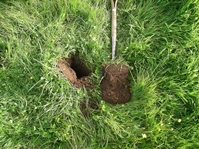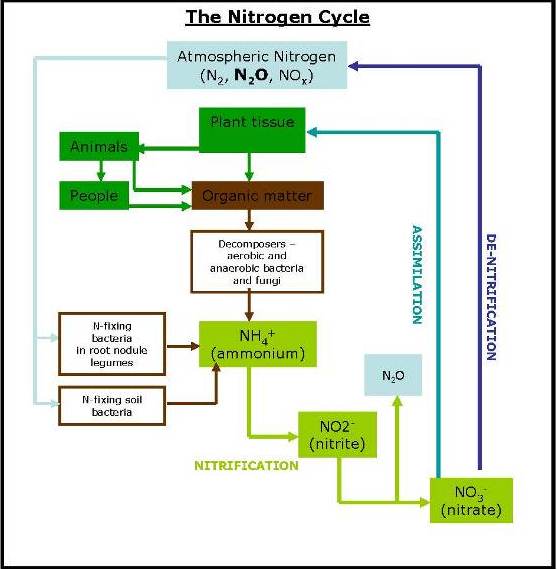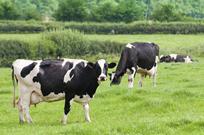The post Emissions from Soil appeared first on Farm Carbon Toolkit.
]]>The continual flux of carbon, methane and nitrogen and the different forms that these elements exist in underpins the dynamics of climate change. Understanding how the management of the soils that we farm fits in with these cycles enables us to make informed choices about the effect of our farming systems on our soils and the effect those practices can have on GHG emissions from our farm. Since both storage and emission capacities may be large, precise quantifications are needed to obtain reliable global budgets that are necessary for land-use management (agriculture, forestry), global change and for climate research.
It is helpful to have a basic understanding of both the carbon and the nitrogen cycles to get a grasp of what’s going on in the soil.
The post Emissions from Soil appeared first on Farm Carbon Toolkit.
]]>The post The Carbon Cycle appeared first on Farm Carbon Toolkit.
]]>
Over 99.9% of all of the earth’s carbon is stored and fixed in the earth’s crust – the lithosphere. This is around 60 – 100 million billion, or gigatonnes (Gt) with just under 0.01% of that stored as fossil fuels (5 – 10,000 Gt). All this carbon is fixed and does not participate in the earth’s carbon cycle, until we bring fossil fuels into use and burn them when the carbon is then released as CO2.
The next largest carbon store is in the oceans, mainly as dissolved CO2 but also as shells coral and other elements (38,000 – 40,000 Gt).
And the next largest carbon store is in the soil at 1,500 – 1,800 Gt stored as soil carbon. This soil carbon could have been added as a result of this year’s cropping or could be a lignified residue from plant growth thousands of years ago that is resistant to microbial decomposition. The soil carbon is stored as organic compounds in the soil organic matter which is divided into three ‘pools’.
Approximately two thirds of all soil organic matter (SOM) is ‘stable’ and extremely resistant to decomposition and can remain unchanged for hundreds or even thousands of years; it is sometimes referred to as ‘humus’. This stable pool is important for soil physical processes, particularly aggregate formation and it also influences the soil cation exchange capacities (the ability of soils to hold onto positively charged plant nutrients).
The remaining third is divided into the ‘slow cycling’ and ‘active’ soil pools, with a constant flux from one pool to the other. The ‘slow cycling’ portion of SOM makes up just over half and is important for the release of nitrogen and phosphorus from the soil for crop growth. It is slowly broken down by biological and mechanical activity and has a turnover time of years to decades. The rest of the SOM is ‘active’, and primarily made up of recently added plant residues in the early stages of decomposition and soil microorganisms. This active pool of soil carbon is important for nutrient release and GHG emissions, and it will have a turnover time of months to years.
The remaining carbon store is in the atmosphere, 800 – 1,000 Gt, and increasing by 6Gt a year as a result of burning fossil fuels, and also in the biosphere which includes all living organisms on the earth (around 540 – 610 Gt).
The post The Carbon Cycle appeared first on Farm Carbon Toolkit.
]]>The post Soil Carbon Emissions appeared first on Farm Carbon Toolkit.
]]>Agriculture and forestry influence the rates of carbon addition and losses to the SOM. Organic carbon and therefore, SOM levels largely depend on vegetation cover and type of plant (root depth and spatial distribution), along with any land use changes. The most significant effect upon the carbon content of the soil is from mechanical cultivation. By cultivating soils the disturbance allows for greater oxidation of the soil profile, therefore promoting the fast metabolism of aerobic species of microorganisms which consequently releases CO2 as a by-product of respiration. Consequently, depending upon a number of factors such as previous cropping, soil type, intensity of cultivation and moisture content, cultivated soils can lose approximately 3 tonnes of soil carbon/ha/year.
This active SOM pool has carbon constantly being added to by plants from their residues, roots and exudates, as these plants take CO2 from the atmosphere to produce simple carbohydrates and all other organic compounds that enable them to grow. The additions and losses of carbon are relatively equal in a steady state system with a (very) gradual increase in SOM. Soils can thus contain between 30 – 90 tonnes of carbon/ha at 30cm depth.

The highest losses of SOM occur in the first year of ploughing out a permanent pasture and if cultivation continues over the next 25 years and can result in 25–40% of the original soil carbon being lost depending on the soil type. Soil surveys in England and Wales from 1978 – 2003 estimated that soil organic carbon decreased over that time by 0.6% per year, which would equate to a loss of 4.4 million tonnes of carbon/yr. Furthermore, where SOM levels were higher than average, the rate of loss of soil carbon was also greater, as much as 2% per year.
Peat soils and soils with very high levels of SOM (>10% SOM) pose additional GHG challenges. Because of the very high levels of SOM, if these soils are cultivated (or drained) the resulting GHG emission can be 4x higher than the same action on an ‘average’ 5% SOM soil.
Arable Farming Techniques for Building Carbon
In many arable systems, mechanical cultivation creates disturbance and consequent oxidation of the soil thereby depleting SOM by microbial action. Where land is under continual cultivation, as is much of UK arable land, reducing the frequency, depth and intensity of cultivations will reduce this soil carbon loss. Changing the crop establishment system to reduce the frequency and intensity of cultivations will provide an immediate reduction in farm GHG emissions.
Depending on the a number of factors, primarily preceding cropping, soil type, intensity of the cultivation and moisture content, cultivated soils can lose 3t of soil carbon/ha/year.
Techniques for arable cropping with no cultivations, known as reduced/ zero tillage are being practiced in the UK. A 2019 report from Defra stated that approximately 50% of the total SOC accumulation (after 100 years) occurs within the first 20 years after converting to reduced tillage soil management. Maintaining SOC at the new equilibrium level then becomes the main priority, which may be dependent on continuing or finding new management practices. However, there is very little data yet to assess what is happening to the SOM under these systems. For more information on how tillage methods can affect soil carbon content read our latest article via here.
This evidence demonstrates how changes in land use (grassland to cropping, cropping to forestry etc) has a significant global impact on GHG emissions both in terms of its source and sink. Recently the UK has been a net ‘sink’ for carbon, however, since 2008 there has been no significant changes in emission reductions from the agricultural sector as a whole, largely due to high demand and intensification of food production.

Grassland farming techniques for building carbon
See our Case Studies section for examples such as at Woodland Valley Farm. Techniques include optimising stocking rates, appropriate sward species and root depth, and adopting permanent pasture.
The post Soil Carbon Emissions appeared first on Farm Carbon Toolkit.
]]>The post Nitrogen Emissions appeared first on Farm Carbon Toolkit.
]]>The Nitrogen Cycle

How is N2O produced?
As in the carbon cycle, in the nitrogen (N) cycle the vast majority, 98% of the earth’s nitrogen, is locked away in the lithosphere, 2% is in the atmosphere (the air we breathe is 78% N gas) and only 0.2% in the soil. It is this 0.2% that is the primary driver of the biochemical nitrogen cycle, and it is the movements of nitrogen in the soil that can give rise to N2O emissions.
Nitrous oxide emissions from the soil result from biological and chemical processes carried out by microbes that use inorganic nitrogen compounds (ammonium, nitrite and nitrate). The processes that release nitrous oxide include microbial nitrification in aerobic soils, denitrification of nitrate in anaerobic soils. Denitrification can result in the release of nitrogen gas (N2) as well as N2O and as these are biological processes the rate at which this occurs is dependent on a number of factors.
A significant factor in the production of N2O is the availability of nitrate (NO3) for the denitrifying bacteria to reduce. Plants take up N from the soil as ammonium, nitrites or nitrates, with the majority as nitrate. NO3 is mineralised from the soil organic matter and is also added to soil as ammonium nitrate fertilizer. Some of the NO2 will be rapidly taken up by plant growth, some will be immobilised into the SOM, some may be leached out of the soil and some is likely to be denitrified. If there is too much NO3 for the plants to take up it is liable to denitrification and leaching.
Why is it important?
Emissions from UK soils as N2O are less significant than CO2, despite N2O being 265 times more powerful a GHG than CO2.
N2O emissions can be seen as a tiny but significant part of soil make-up, due to its huge carbon equivalent, as well as being essential for biological processes that enable soil microbes to flourish.
The soil nitrogen is present either as inorganic nitrogen (available for plant uptake) or organically bound nitrogen in the soil organic matter. In general over 90% of all soil nitrogen is in organically bound in the SOM. The majority is in the ‘active’ and ‘stable’ pools, and is mineralised into inorganic nitrogen and made available for plant uptake, or loss from the soil, by the action of soil micro-organisms oxidising the SOM.
Minimising Emissions
The vast majority of denitrifying bacteria require relatively anaerobic conditions. Soils need to have a field capacity of over 60% for dentification to occur and so improving soil structure and adequate drainage can be significant factors in reducing N2O emissions. This can be done by adopting methods such as reduced tillage as well as introducing legume crops in to the rotation which will provide more nitrogen in the form of organic matter which will be released more slowly and used effectively by growing plants (Government of Western Australia, 2018).
Temperature, available carbon and pH are also important variables – the dentrifying bacteria will be most active in warmer soil conditions with higher SOM (and available soil carbon and energy) and with a pH of 7.0 – 8.0.
The post Nitrogen Emissions appeared first on Farm Carbon Toolkit.
]]>The post Methane Emissions appeared first on Farm Carbon Toolkit.
]]>Methane cycle
Methane (CH4) is not a significant GHG for UK agricultural soils, where the UK is more of a sink due to the action of soil bacteria converting the methane into more complex soil carbohydrates. Deciduous woodland with a relatively high pH soils has been shown to have the highest rates of methane uptake in the UK along with wetland areas. The influence of different plant species on this uptake of methane in wetland areas can be read here. Overall, it was found that where soil organic carbon measurements where high, methane emissions were low. Therefore suggesting that plant species and their density can influence methane emission from wetlands, and should be considered when developing climate change mitigation policies and plans.
Soils which have had regular fertilizer additions or have high ammonium content have been shown to have much smaller populations of methanotrophic bacteria (those bacterial populations that remove methane) and are therefore not very effective methane sinks; while soils which have organic manures added to them have been shown to have higher than average populations of methanotrophic bacterial populations.

The post Methane Emissions appeared first on Farm Carbon Toolkit.
]]>The post Carbon Sequestration appeared first on Farm Carbon Toolkit.
]]>Unlike any other industry except forestry, farming has the potential to sequester (absorb) carbon dioxide out of the atmosphere on a large scale. Plants and soils on farms have the potential to sequester vast amounts of carbon, giving farming the potential to be at the forefront of the fight against climate change.
Much of the biomass that commonly occurs on UK farms such as hedges, woodland and permanent pasture is already sequestering carbon at very significant levels. But with some careful management decisions this can be improved to maximise the rate at which carbon sequestration occurs. Furthermore, more biomass usually equates to better habitat for wildlife, particularly insects and birds.
Soil is the farmers’ most important asset in so many ways. A soil that is continually gaining in organic matter, which is certainly possible, is a rich, healthy and resilient soil. Increases in organic matter lead to increased soil fertility, improved structure, healthier crops and carbon sequestration.
How does it work?
When plants photosynthesise they absorb carbon dioxide (CO2). This CO2 is turned in to sugars and then more stable compounds. In woody plants like trees this becomes lignin (wood), and suddenly the CO2 that was once in the atmosphere has become a very stable form of elemental carbon.
Some of the plant’s carbon compounds are also exudated (transferred) into the soil via the roots. Here the carbon compounds become organic matter and build soil organic matter, another very stable form of carbon.
Soils contain organic matter that is created from organic matter from animals, insects, plants and fungi. This organic matter is then decomposed by the vast array of micro-organisms in the soil ecosystem. About half of all organic matter is carbon, and in this form the carbon is very stable and can only turn back to CO2 readily if significant oxidation occurs, such as cultivation.
Eventually soil organic matter turns in to the even more stable form of humus, a highly complex, fertile and stable substance that should be prized by every farmer.
The post Carbon Sequestration appeared first on Farm Carbon Toolkit.
]]>The post Soils for Sequestration appeared first on Farm Carbon Toolkit.
]]>Good soil management is central to sustainable farming everywhere. Healthy soils are any nation’s greatest asset and, if well managed, can go on producing food, fibre and fuel for generation after generation. However much UK farmland is badly degraded, following farming practices that have not looked after the soil, effectively raiding the ‘soil capital bank’.
Fortunately soils have an extraordinary capacity to regenerate quickly and become productive and stable again.
Healthy soils have numerous benefits for the farmer and society:
- Stable and resilient
- Resistant to erosion due to stable and improved soil structure. This leads to improved water quality in groundwater and surface waters, and ultimately to increased food security and decreased negative impacts to ecosystems.
- Easily workable in cultivated systems
- Good habitat for soil micro-organisms
- Fertile and good structure
- Large carbon sinks
Basic Principles to Create Healthy Soils:
Cultivation can reduce soil structure and oxidise carbon, which is then released to the atmosphere. Minimising cultivation frequency and depth alongside ensuring the soil is not too wet when cultivated can reduce the damage arising from incorrect management.
Perennial crops (including grasses) are good for soil because they encourage organic matter formation:
- Diverse cropping systems (cultivated and grassland) introduce vegetative variety into soils which stimulates soil biology
- Evaluate machinery operations: minimise depth, frequency and proportion of soil inverted if avoidable
- Build soil organic matter as much and as frequently as possible!
The Importance of Soil Organic Matter
Healthy soils support a large and diverse microbial community, the interactions between species and niches increases soil functionality to decompose residues and stabilise organic matter. Previously degraded soils that become more sympathetically managed will tend to increase in soil organic matter content at the fastest rates, however, all soils can continue to build organic matter as the depth of high carbon content in the soil increases.
Building soil organic matter is a holy grail for the farmer or grower and is also a win, win situation:
- Healthy soils produce healthy crops
- Crops growing in healthy soils give higher yields and higher profits
- Soils high in organic matter are resilient, stable and have good structure
- Carbon sequestration rates can be huge
Work completed by the FCT has demonstrated that every hectare of land that raises its soil organic matter levels by just 0.1% (e.g. 4.2% to 4.3%) can sequester approximately 8.9 tonnes of CO2e per year (at 1.4 g/cm3 bulk density). This is an extraordinary figure; in practice that is not only possible but being exceeded by farmers and growers building healthy soils.
The post Soils for Sequestration appeared first on Farm Carbon Toolkit.
]]>The post Sequestration for Biomass appeared first on Farm Carbon Toolkit.
]]>Hedges
Britain’s landscape is full of hedges, which can take many different forms, ages and species composition. Generally, the higher and wider the hedge the more carbon will be sequestered. Traditional methods of laying created hedges, in rotation, that grew vigorously, were stock-proof and absorbed a lot of carbon. This can be replicated to an extent by well-planned mechanical management and consideration of the frequency of fresh growth.
Woodland
Trees have an astonishing capacity to absorb carbon across their lifetime. However, the peak period for sequestration is in a tree’s teenage years! Depending on the species this ranges from years 10 to 45 after planting, where sequestration rates are in excess of 12 tonnes of CO2 per hectare per year.
If your farm has a policy of continual tree planting you will ensure that there are always trees in the age-classes that maximise sequestration. Of course it also means you will always have a ready supply of timber!
Orchards
Traditional orchards are Britain’s ancient form of agroforestry, with ancient trees providing fruit and wildlife habitat, whilst underneath the trees permanent pasture provides grazing for livestock. Carbon is absorbed in the wood of the trees and the grassland builds organic matter in the soil.
Modern bush orchards may not have the capacity for livestock grazing, but if well managed can still provide significant carbon benefits as well as high fruit and/or nut yields. It’s their perennial nature which makes orchards so important in carbon terms. Orchards, whether bush or traditional, are important carbon sinks that, unlike woodland and hedges, also provide food for humans.
Field margins
Any grassland that is not cultivated is an important carbon asset, for organic matter can build and is not lost when cultivated. All fields have margins that are carbon sinks. Whilst there is always a trade-off between margin area and annual crops in a cultivated field, it’s worth considering that margins have greater value than just being able to turn a tractor around on.
There are many novel ways to integrate perennial crops with annual crops, such as agroforestry. Forest gardens are a way of essentially creating woodland that is entirely edible and useful to humans as well as wildlife.
Coppice woodland offers potential for huge sequestration rates, meaning less land has to be given over to trees for the same carbon benefit. Coppice typically has a range of useful wood products following cutting, such as stakes, poles, weaving material and fuel. Any perennial crops are worth considering for carbon and other benefits, whether for biofuel like Miscanthus or even soft fruit like blackcurrants.
The post Sequestration for Biomass appeared first on Farm Carbon Toolkit.
]]>